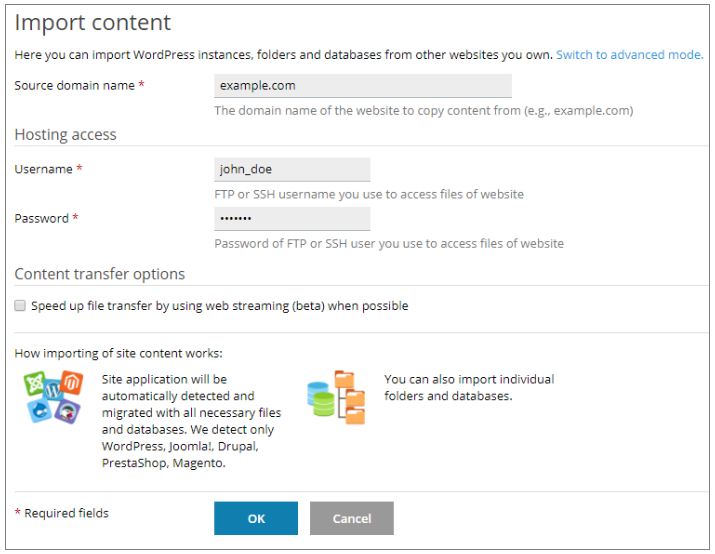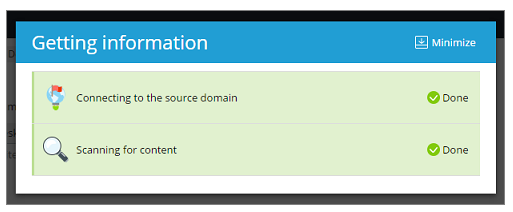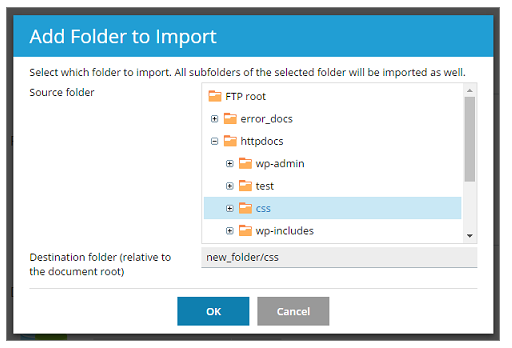Importing Websites via FTP
You may want to import content from a different website that belongs to you but is hosted elsewhere into Plesk![]() Plesk Panel is the preferred choice for hosting service providers, web designers, and website owners. Plesk Obsidian 18 is the latest release from Plesk and offers a range of new benefits and features for every user type.. Use the Site Import extension to import certain applications, folders with files, and databases. You can import content from servers running both Linux and Windows, and even from servers that do not have Plesk installed.
Plesk Panel is the preferred choice for hosting service providers, web designers, and website owners. Plesk Obsidian 18 is the latest release from Plesk and offers a range of new benefits and features for every user type.. Use the Site Import extension to import certain applications, folders with files, and databases. You can import content from servers running both Linux and Windows, and even from servers that do not have Plesk installed.
Starting a Website Import
By default, website import is performed in simple mode. In simple mode, you only need to specify the source website’s domain name and the username and password of the FT user that has access to the source website’s files. Plesk tries to automatically detect and apply optimal settings for the import.
- To start importing content in simple mode:
- Go to Websites & Domains, select the domain you want to use as the target for importing content, and then click Website Importing.
- Specify the domain name of the website you want to import content from in the “Source domain name” field.
- Specify the username and password of an FTP
 File Transfer Protocol (FTP) is a standard network protocol used to transfer files from one host to another host over a TCP-based network, such as the Internet. user on the source server that has access to the source website’s files.
File Transfer Protocol (FTP) is a standard network protocol used to transfer files from one host to another host over a TCP-based network, such as the Internet. user on the source server that has access to the source website’s files. - Select the “Speed up file transfer by using web streaming (beta) when possible” checkbox if you want to import a large number of small files, or if you suspect that the import may be interrupted (for example, because of unstable Internet connection or insufficiently large PHP
 PHP is a general-purpose server-side scripting language originally designed for Web development to produce dynamic Web pages. It is one of the first developed server-side scripting languages to be embedded into an HTML source document rather than calling an external file to process data. maximum execution time). Selecting the checkbox enables Plesk to resume interrupted import instead of starting over.
PHP is a general-purpose server-side scripting language originally designed for Web development to produce dynamic Web pages. It is one of the first developed server-side scripting languages to be embedded into an HTML source document rather than calling an external file to process data. maximum execution time). Selecting the checkbox enables Plesk to resume interrupted import instead of starting over. - Note: This feature is still in beta, so only select the checkbox if you do not mind potentially encountering bugs in exchange for increased import speed.
- Click OK.

Plesk will try connecting to the source website and scanning it for content. If the connection is successful, select one or more objects of the following types types to import:
- Applications
- Folders
- Databases

If the connection is not successful, make sure that the following requirements are met and try again:
- The source website’s domain name resolves to the correct IP address
 An Internet Protocol address (IP address) is a numerical label assigned to each device (e.g., computer, printer) participating in a computer network that uses the Internet Protocol for communication. An IP address serves two principal functions: host or network interface identification and location addressing from the target server.
An Internet Protocol address (IP address) is a numerical label assigned to each device (e.g., computer, printer) participating in a computer network that uses the Internet Protocol for communication. An IP address serves two principal functions: host or network interface identification and location addressing from the target server. - The FTP username and password are correct. The FTP user has access to all files and directories of the source website.
- You can connect to the source server via FTP from the target server.
If the connection is successful but scanning for content fails, you can try importing in advanced mode. In advanced mode you can explicitly choose the connection type, specify the document root, choose the protocol for data transfer, and more.
To start importing content in advanced mode via FTP:
- Go to Websites & Domains, select the domain you want to use as the target for importing content, and then click Website Importing.
- Click “Switch to advanced mode”.
- Specify the domain name of the website you want to import content from in the “Source domain name” field.
- Under “Connection type”, select “FTP”.
- Specify the username and password of an FTP user on the source server that has access to the source website’s files in the corresponding fields.
- Select the desired method for transferring content under “Way to transfer files”:
- (Recommended) If you keep “Automatic”, Plesk will use FTP to import content.
- You can also have Plesk use web streaming by selecting it from the list. Web streaming is good when you need to import a large number of small files or if you believe that the import may be interrupted, but choosing it may cause issues with the import.
- Specify the document root of the source website starting from the FTP user’s home directory in the “Source document root” field.
- For example, if the document root of the source website is /var/www/vhosts/example.com/httpdocs and the home directory of the FTP user is /httpdocs, specify /httpdocs in the “Source document root” field and keep the “File root” field empty.
- Specify the full URL
 In computing, a uniform resource locator (URL) (originally called universal resource locator) is a specific character string that constitutes a reference to an Internet resource.
Both www.webnames.ca and www.webnames.ca/domain are examples of a URL corresponding to the document root of the source website in the “Source website URL” field.
In computing, a uniform resource locator (URL) (originally called universal resource locator) is a specific character string that constitutes a reference to an Internet resource.
Both www.webnames.ca and www.webnames.ca/domain are examples of a URL corresponding to the document root of the source website in the “Source website URL” field. - For example, if the document root is /var/www/vhosts/example.com/httpdocs, specify https://example.com in the “Source website URL” field.
- If the document root is var/www/vhosts/example.com/httpdocs/my/wordpress, specify https://example.com/my/wordpress in the “Source website URL” field.
- You can specify an FTP server charset other than the default “UTF-8” to prevent corrupt encoding when importing from an old source server. To do so, select the desired charset from the “FTP server charset” drop-down list or use search.
- Keep the “Use the same IP for FTP data connection as for FTP control connection” checkbox selected. You need to clear this checkbox only if the FTP server is configured in such a way that command and data channels use different IP public addresses.
- Click OK.
Importing Applications
When a website importing is initiated, Plesk scans the source website for the presence of certain applications and lists them. Currently, you can import the following applications to the target server:
- WordPress
- Joomla
- Drupal
- PrestaShop
Plesk can import an application from the source website to the target, including all its files and the database.
Warning: When importing an application, if there is already an application installed on the target domain, its files may be overwritten. We strongly recommend backing up the target domain before importing applications.

When importing an application, keep in mind the following limitations:
- The application must use a MySQL
 MySQL is the world's most used open source relational database management system that runs as a server providing multi-user access to a number of databases. database.
MySQL is the world's most used open source relational database management system that runs as a server providing multi-user access to a number of databases. database. - The MySQL database server must use the default port.
There may also be additional requirements specific to the application you want to import. You can find them in the application’s documentation:
- WordPress
- Joomla
- Drupal
- PrestaShop
Note: Plesk cannot automatically check if the application you want to import meets the requirements. Make sure that the application meets both general and application specific requirements before starting importing.
To import an application, follow these steps:
Select the checkbox(es) next to the application(s) you want to import.
By default, the application files are placed in the same location relative to the document root they occupied on the source. If desired, you can change where to place the application files on the target server. To do so, click the / link under “Destination Path” and type in the path to the destination folder (relative to the document root).
Click Start Import.
The installation’s status will change from “Ready for import” to “Queued”, and then to “In progress”. Once the status changes to “Imported”, application importing was finished.
Synchronizing Imported Applications
At any time after you have imported an application, you can import it again by selecting the corresponding checkbox and clicking the Re-sync button. Note that this will overwrite any changes you may have made to the installation on the destination server.
Importing Folders
You can use the Site Import extension to import individual folders with all included files and subfolders from the source website to the destination.

To import a folder, follow these steps:
- Under “Files”, click Add Folder to Import and browse to the folder you want to import. Optionally, you can specify the desired location for the folder on the destination server, relative to the destination website’s document root directory.
- Click OK.

All subfolders of that folder, as well as all files within those folders will be imported as well.
Synchronizing Folders
At any time after you have imported a folder, you can import it again by selecting the corresponding checkbox and clicking the Re-sync button. Note that this will overwrite any changes you may have made to the folder or its contents on the destination server.